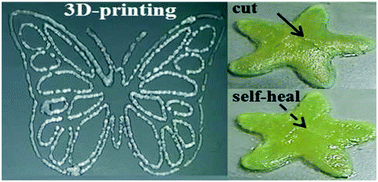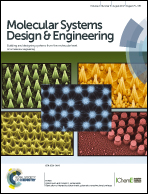2D and 3D-printing of self-healing gels: design and extrusion of self-rolling objects†
Abstract
In this work, we report the synthesis, characterization and three-dimensional (3D) printing of self-healing gels. The gels are prepared by cross-linking benzaldehyde-functionalized poly(2-hydroxyethyl methacrylate) (PHEMA) with ethylenediamine (EDA) to form dynamic imine bonds. An immediate gelation was observed within seconds, followed by a full maturation, enabling time independent and stable printing. The self-healing gels showed 98% recovery from mechanical damages. To establish a printable window for our well-defined system, and to allow robust printability, we examined a broad number of ink formulations. To tune the rheology towards the formation of soft and extrudable, yet stable and self-supporting materials, we examined self-healing gels with controlled degrees of cross-linking and polymer concentrations. Single-layer patterns and self-healing objects with tunable layer thicknesses and shapes were successfully 3D-printed, with their self-healing capabilities fully retained. After post-printing reinforcement by further imine cross-linking, the swelling properties of these 3D-printed functional structures were employed for the fabrication of self-rolling, dynamic objects. These self-healing “smart” objects could change their shape and axes of folding by sensing their chemical environment.



 Please wait while we load your content...
Please wait while we load your content...